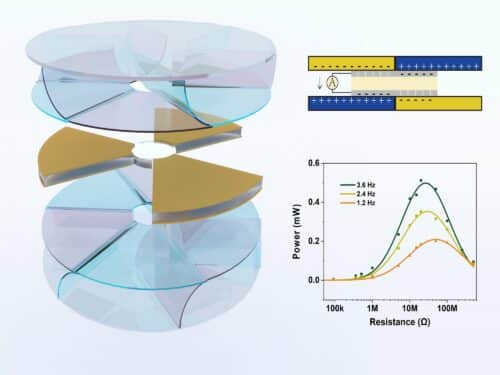Researchers have developed triboelectric nanogenerators with a constant inherent capacitance that could increase their energy conversion efficiency and electric storage capacity

Traditional triboelectric nanogenerators implement time-dependent capacitance. Triboelectric generators are mechanical energy harvesters that produce electricity when two surfaces rub against each other. To enhance the energy conversion efficiency of such nanogenerators, researchers from China have developed a nanogenerator with a constant inherent capacitance. The efficiency of nanogenerators to convert energy into electric charge depends on the ability of their capacitors to store those electric charges.
“Triboelectric nanogenerators can provide a feasible way to convert mechanical energy into electricity,” said Youfan Hu, a professor at the School of Electronics at Peking University in China. “With improved efficiency and sensitivity, even very weak mechanical energy ‘hidden’ in the environment can be caught and utilized.”
The researchers experimented with capacitors by charging them using three different styles of power conditioning circuits and testing the performance of the two different triboelectric nanogenerators. They noted that both triboelectric nanogenerators worked better on a full wave power circuit but that the constant inherent capacitance triboelectric nanogenerators were able to store approximately two times the charge compared to the time-dependent inherent capacitance triboelectric nanogenerators. This shows how using the constant inherent capacitance triboelectric nanogenerators can provide better performance. They also found that this form of nanogenerator could charge very quickly.
Furthermore, to show its application in the real world, researchers developed an anemometer based on their technology. An anemometer measures wind speed and direction. When the kinetic energy of the wind moved the cups on the anemometer, the triboelectric nanogenerator was able to turn that information into an electric signal, which could be processed as the measurements of the wind speed. The anemometer was able to process the information in real time and send it to the researchers.
It is easy to manufacture this style of triboelectric nanogenerator, and researchers predict that their device will be made more practical and could be used for a wide range of applications. “The next step is to miniaturize the device and optimize the power management circuits. Ultimately, triboelectric nanogenerators will be able to serve in an integrated electronic system with a small footprint,” said Hu.
Click here for the Published Research Paper







